Outdoor transplant and further care
The timing of planting young seedlings in open ground depends on the characteristics of the region. In the middle lane, work is carried out in early spring or in autumn before leaf fall. In colder regions, spring planting is preferred. Spirea can be planted both in a well-lit and in a slightly shaded place. It is not worth placing a shrub in the shade, since its inflorescences will begin to shrink from a lack of light. It is worth considering that in a shady place most varieties of tree peonies, clematis, large-leaved hydrangeas will not take root.
The blanks rooted in September-October are transferred to the garden next spring. Cuttings that take root in spring and summer can wait until fall or next spring.
In order for the young spirea to grow and bloom, the soil on the site must be slightly acidic or neutral, loose, permeable. If the soil is heavy, then the size of the planting pit is increased several times by placing a drainage layer on the bottom.
When organizing the landing and caring for the chubushnik, this rule is also taken into account.
Even a beginner can plant a young spirea in the garden, guided by a few simple tips:
- Planting work begins with the preparation of a nutrient substrate for filling the hole from 2 parts of garden soil, 1 part of sand and 1 part of peat.
- Dig planting holes 1.5-3 times wider and deeper than the size of the root system of the seedling. Pebbles, broken brick and coarse sand are placed on the bottom.
- Carefully remove the seedling from the pot, send it into the pit and straighten the roots.
- The bush is covered with a substrate prepared in advance so that the root collar remains at ground level.
- The trunk circle is abundantly watered and mulched.
If it is decided to plant several spirits, then 50-70 cm are left between the bushes.When creating a hedge, it is enough to provide a distance of 40-50 cm.
Video with recommendations for growing garden spirea by cuttings.
In the first years of growth, more painstaking care is required for the shrub:
- The primary condition for the rapid acclimatization of the spirea bush is moderate humidity. Since the root system lies close to the surface, it can dry out on hot days. Watering should be moderate; on rainy days, the bush can do without additional moisture.
- For additional protection of the roots and preservation of the necessary moisture, the trunk circle is periodically mulched with peat and tree bark.
- The cultivation of decorative spirea is impossible without the introduction of fertilizers. In the spring, the bush needs a liquid mineral complex, in the summer - organic matter and superphosphate. All fertilizers are applied after watering.
- For the winter, young shrubs are sheltered from the cold. The branches are tied together, bent to the ground, sprinkled with dry leaves with a layer of 10 cm, spruce branches are put on top.
- Pruning is a mandatory procedure to preserve the beautiful appearance of the spirea. The first haircut is carried out after wintering. All frozen and dry branches are cut off completely.
Cuttings are the most popular breeding method for perennials. Both green and lignified shoots root well, germinate quickly and do not require special maintenance conditions, from which it follows that even a novice gardener can grow a wildly blooming spirea from cuttings.
Helpful hints
To propagate spirea by cuttings, you do not need to be a professional gardener. This procedure is quite simple, even a beginner can handle it. For successful breeding of a shrub, you can use the following useful recommendations:
- to protect cut shoots from diseases and parasites, they can be treated with a solution of potassium permanganate;
- the best "neighbors" in the garden are coniferous crops;
- when landing in a permanent place, it is recommended to lay a drainage from brick chips or a mixture of sand and pebbles into the hole;
- for one year after planting the spirea in the garden, the plant needs careful care; watering should be carried out constantly so that the roots cannot dry out;
- during active growth, bushes transplanted into open ground need to be fed; mineral compositions and organic fertilizers can be used as top dressing.
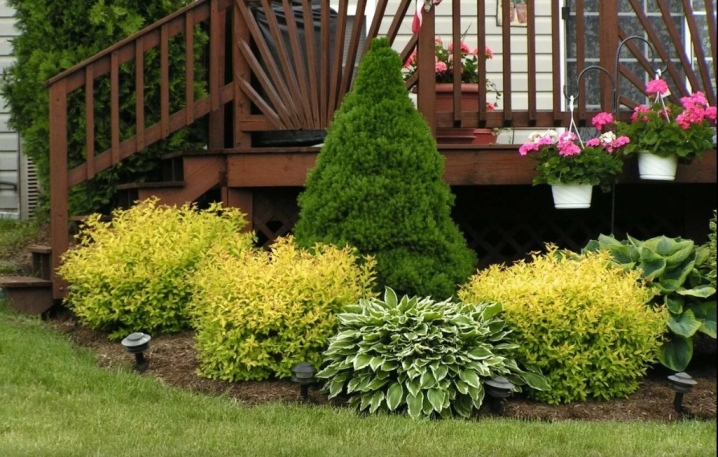
You can learn more about the propagation of spirea by cuttings from the video below.
Vegetative propagation of spirea
How to propagate spirea by cuttings
Most of the spire propagates by cuttings, and both green, summer and semi-lignified autumn cuttings are used for rooting. Cuttings are the most productive way: cuttings of such spirits as Wangutta, willow, slate, dwarf, nippon, white-flowered, medium, low and dense-flowered are successfully rooted in 70% of cases. Cuttings of birch-leaved and oak-leaved spiraea have one hundred percent success, and only one third of the cuttings of sharp-toothed spirea take root.
Experienced gardeners prefer to propagate spirea by cuttings in autumn, September or October, although spring-flowering species can be cut from the first half of June, and late-flowering ones from July. Strong shoots are separated from the bush and divided into parts with 4-5 leaves on each. The bottom leaf is removed from each cutting, and the top ones are cut in half. Semi-lignified cuttings are soaked for 2-3 hours in water, and immediately before planting, the lower part of each segment is powdered with a root former.
Cuttings are planted at an angle of 45˚ in a substrate consisting of equal parts of coarse river sand and high-moor peat, and covered with a transparent dome. Caring for the cuttings consists in regularly ventilating and moistening the substrate, as well as in daily spraying the cuttings from a fine spray with cold water. Summer cuttings are planted in a permanent place in the spring, and winter ones - in the fall. During transplantation, root picking (shortening) is carried out.
Spirea propagation by layering
This breeding method also gives reliable results. In early spring, the shoot of the spirea bush is laid in a dug groove, pinned in it and covered with earth. The top of the shoot must remain above the ground. If you need to get several seedlings from the cut, you need to pinch the top. During the season, the layers are watered together with the mother plant, sprinkling the shoots growing from it with humus, and in the fall they dig it up, divide it into parts and plant them in pre-prepared pits.
Reproduction of spirea by dividing the bush
Divide those spirea bushes that are 3-4 years old, since in older plants the root system is tied up with a too dense earthen lump, which is difficult to destroy without damaging the roots. You can divide the bush at any time, except in winter, but it is better to do this in late summer or early autumn. It is advisable to guess the time so that after the completion of the procedure, the weather will be cloudy for several days.
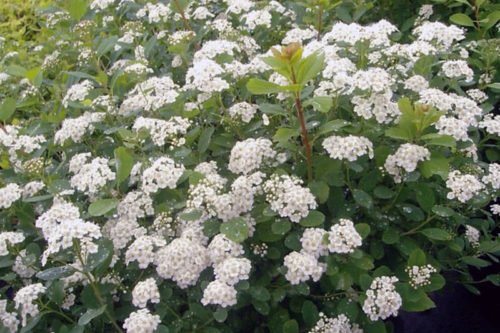 White spirea on the site
White spirea on the site
A spirea bush is dug out, trying to damage as few roots as possible. Although, most likely, the peripheral roots will have to be chopped off. The root system is thoroughly washed, and in order to remove all the earth, the roots are placed in a container of water for an hour. Spread the root shoots, divide the bush with sterile pruning shears into approximately equal parts, each of which should get several shoots and a ball of roots. The roots must be slightly shortened, and the cuts must be processed with crushed coal. Delenki are planted in pits prepared in advance and watered abundantly several times. If it's hot, the first time you have to water them daily.
Breeding methods for Spirea in spring and autumn
Cuttings
For spirea, cuttings are considered the most favorable reproduction.Since this is a vegetative method of propagation, all the characteristics of the variety are preserved during cultivation.
Cutting by stages:
Only young shoots are suitable for cuttings, preferably annuals or younger, which grow strictly straight. A sprout is cut off, on which there should be 4-5 nodes with double leaves, the lower pair of leaves is removed. It is recommended to make cuts at an angle, the length of the cut cutting is 10-15 cm.
For better reproduction, after cutting, the cuttings are placed in a solution of Epin or Zircon (another biostimulator is also suitable) for 9-11 hours, the solution is made up in a proportion of 1 ml of biostimulant to 2 liters of water. It will not be superfluous to use root-forming powder stimulants - Ukorenit, Kornevin. They are sprinkled on the ends of the cutting.
The next step is placing the cuttings in wet sand. They should be positioned at an angle and deepened by 2-3 cm, then sprayed and covered with a jar or film. It is better to place the container with sand in a place protected from direct sunlight.
The container with cuttings is taken out into the street, located in a shady area; cuttings require regular spraying and watering. By winter, they are covered with foliage, and in the spring they are already planted in open ground.
Video about the propagation of Spirea by cuttings
Layers
An easier way. Suitable if you need to get a small amount of sprouts. In spring, young branches of spirea (preferably lower shoots) fall to the ground, pinned with a twig or V-shaped wire. Sprinkle with soil on top.
Next spring, the root system of the shoots will be fully formed. You can separate the shoots from the main spirea bush and transplant for independent growth.
Seeds
A convenient way to get a lot of spirea sprouts at once. However, there are some subtleties here too. Seed propagation is not suitable for all types of this shrub. If there is no 100% certainty or it is impossible to determine the type of spirea by the seeds, a test sowing of the bush can be carried out. In the fall, I plant a few seeds in a pot (the amount is optional), water it well and sprinkle it with soil in an open area, for the winter, respectively, the sprouts are insulated. In the spring, it will be possible to determine the type of spirea from the seedlings.
Propagated by seeds can only be Japanese spiraea, Nipponskaya and Dubravkolistnaya. Seeds of other species and varieties do not germinate well, and their hybrids may change in the future.
Several simple steps of seed propagation
In the summer, boxes with seeds are cut from shrubs, placed for 2 weeks in a dark, dry place to ripen
It is important to have time to cut the boxes before they open (in July - August)
Further, the seeds are harvested, and they can be planted in a box from mid-October to the whole of November, or in spring in April. The soil should also be prepared in a 1: 4 ratio - vermiculite and non-acidic peat, respectively. The box on the site is sprinkled with soil, if sowing is carried out in spring, the soil in the box should be thoroughly sprayed and covered with a film before the first shoots of seeds; regularly monitor soil moisture.
After several months, the sprouts should be dived. By this time, they usually reach a height of 2-3 cm; are seated at a distance of 8-10 cm from each other.
The box is again sprinkled with soil, it is advisable to place it in a shady place for the summer and water it regularly.
In the fall, the sprouts can be transplanted into open ground on the beds, and only after a year to the chosen permanent place for them. Spirea sprouts take root and adapt well, but they will begin to bloom no earlier than three years later.
Choosing a spirea as a decoration for a site, it is impossible to regret your choice in the future. This shrub pleases with long flowering, unpretentiousness. It can be propagated and transplanted at almost any convenient time, and with the help of chic forms, you can create unique landscapes and compositions.Spireas can perform decorative functions in the garden, delight the eye with single flowering shrubs, or serve as a hedge.
I have a spirea grefsheim, at their summer cottage. This is an unusually beautiful plant, which, as it turned out, is not demanding to care for. I fertilize once a season with a universal fertilizer, and she pleases me with her appearance. She has already provided her with all her neighbors. I propagate by layering (I just pin the twig to the ground and periodically moisten the soil). Who does not have spirea, I strongly advise.
Reproduction of spirea
Spirea propagates by seeds and vegetatively: by dividing the bush, layering and cuttings.
Growing spirea from seeds
Not all types and varieties of spirea are propagated by seeds, but only those that form a full-fledged seed, for example, Japanese spirea, Nippon and oak-leaved. Brown, but not yet opened seed pods are cut off, ripened indoors in a cardboard box, and after two weeks the ripe seeds are poured out of them. Sowing is carried out in the spring in a shallow box filled with a mixture of 4 parts of peat and one part of vermiculite. The seeds laid out on the surface are not sealed, but sprayed from a spray bottle, after which they are covered with film or glass and placed under diffused light. From the moment the shoots begin to appear, the cover is removed, and the seedlings, along with the box, are taken out into the garden. As soon as the seedlings reach a height of 2 cm, they are dived in separate containers, shortening too long roots by a third, and in the second half of August, the seedlings are determined on the school garden. Young plants are planted in a permanent place next spring.
Reproduction of spirea by cuttings
This is the most effective way to reproduce spirea with a high survival rate of 70%. Cut spirea like spring, and at the beginning of summer, most often using plant residues from pruning. The length of cuttings with at least four internodes and an oblique lower cut should be 10-15 cm. The lower pair of leaves is removed, and the rest are shortened by half. Before planting, the cuttings are kept in a solution of a growth stimulator - Epin or Zircon for half a day, after which the lower cut is powdered with Kornevin. Cuttings are planted in a container with wet sand, after which they are sprayed and covered with a transparent cap. As soon as new leaves begin to appear on the cuttings, the film is removed from them, the container is taken out into fresh air and placed in the shade. Caring for cuttings consists in regularly spraying and watering the soil. With the onset of cold weather, the container is placed in a frost-free cellar or dripped in the garden, covered with burlap or dry leaves on top, and with the arrival of heat, the cuttings are planted in a permanent place.
Spirea propagation by layering
Propagate spirea by layering easily. To do this, you need to bend a low-growing branch or young growth to the ground, fix it in this position and sprinkle it with earth. Layering care consists in regular watering and feeding. Keep in mind: if you completely cover the layer with earth, it will give numerous shoots, and if you leave the top of the shoot above the surface, then in the spring it will form a developed single plant.
Reproduction of spirea by dividing the bush
It makes sense to propagate the spirea by dividing the rhizome only when transplanting a bush. You can divide a plant that has reached three to four years of age throughout the season. Please note that the survival rate of the divisions improves if the weather is cool, cloudy for 7-10 days after transplantation.
The bush is dug out by chopping off the roots that extend too far to the sides. The root system is placed for an hour and a half in a container with water so that the earth comes off it. With a sharp sterile knife or pruner, the bush is divided into several parts so that each of them has a root lobe and 2-3 developed shoots. The cuts are sprinkled with crushed coal, after which the cuttings are seated in pre-prepared planting pits.After planting, the surface is compacted, watered and mulched with humus or dry peat.
Reproduction of spirea in summer using cuttings
Knowing how spirea reproduces in summer, it is better to choose cuttings as cultivation. Thus, the bush is propagated using green or woody cuttings, depending on the season. It is worth taking annual or last year sprouts, the bark of which remains light on growth. Cuttings of such a spirea are carried out in the summer, but the sprouts themselves are prepared in cloudy weather.
Important! Planting materials are cut only from healthy bushes, if pests are present, you will need to process the main plant
Spirea cuttings
To root the cuttings well, the spirea is pruned; green shoots are chosen for this procedure. Their tops must be cut off to avoid rotting, in which case even novice gardeners will be able to plant. The prepared cutting should not have leaves in the lower part, it is enough to leave only the four upper ones. The leaf plate itself is made shorter by a third.
The cuttings are moistened from below in a solution of potassium permanganate, then the shoots are planted in a substrate with the addition of a nutrient concentrate. Each branch should be at a depth of at least 1.5-2 cm, between which a gap of 3 cm is left. For the purpose of rooting, a place in the shade that is well ventilated is suitable. Shoots are additionally covered with a bag or glass to create a greenhouse effect. They are planted in a permanent place after complete rooting.

Reproduction of spirea
Features of cuttings of Japanese spirea in summer
Japanese spirea, or a bride, whose full care and reproduction should be carried out according to the rules, has its own differences. You need to plant cuttings at least 7-15 cm long, taking into account the size of the main plant. Their shoots are cut with a razor or a sharp knife just below the node, the leaves are removed from the lower side. Then the ends of the cuttings are dipped into a solution with phytohormone. Once they have been there for a few hours, they can be planted in pre-prepared holes in the soil.
How to root a white spirea from a twig
You can easily root a white spirea or a Vangutta bush from a twig at home
It is important to plant the shoots in the substrate so that they form a root system faster. To prepare it, sand and high moor peat are mixed.
The cuttings are kept in solution in advance, then dipped in a growth stimulator, then transplanted into the soil. In order to disinfect the planting, you can spray it with a garlic solution, adding 1 teaspoon of the resulting gruel to 1 liter of water.
Rooting
To stimulate root growth after cutting the branches, it is recommended to put it in a special composition for a while. In the store for these purposes, you can buy products such as "Kornevin", "Heteroauxin" and "Vympel". After processing the branches, they must be planted in small containers. Let's consider the rooting process in stages.
To root shoots at home, you first need to prepare the substrate. The easiest way is to use wet sand. You can also mix sand from peat or use any other loose soil. It is recommended to treat the substrate with a fungicide to prevent root rot.
As for the container in which the branches will be planted, any containers with holes at the bottom are suitable here. It is necessary to plant cuttings correctly at a depth of 3 cm at an angle of about 45 degrees.
It is necessary to observe the angle of inclination so that the growth of the upper parts of the branches slows down, and root formation, on the contrary, is activated.
It is important that the soil is moist during planting. After the branches are immersed in the substrate, they also need to be sprinkled with water.
It is advisable to cover the cuttings on top with a film or a cap from a plastic bottle. This manipulation is necessary to create conditions of high humidity and maintain temperature.
Periodically, the seedlings are taken out of the shelter and moistened with a spray bottle.During cultivation, it is important not to allow the soil to dry out, but at the same time, do not overmoisten the spirea. Containers with cuttings should be removed to the windowsill, where the sunlight will not be too bright.
As an alternative to keeping the seedlings for rooting, bury the containers in the garden. From above, you need to put dry leaves or peat on the ground so that the root system does not freeze. In winter, the container with seedlings is removed to the basement or transferred to another dark, cool place.

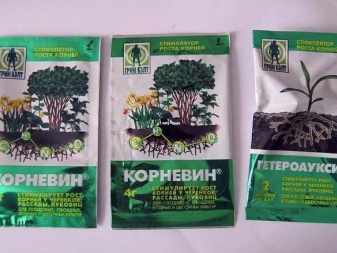
You can grow shoots not only in pots. If desired, a greenhouse is built on the site under the spirea.
- First, a garden bed is dug up, organic fertilizers are applied. It is recommended to add peat mixture and river sand to the ground. Then it is recommended to moisten the soil well.
- The branches are planted at a distance of at least 10 cm from each other. Next, you need to install the greenhouse frame and stretch the film on top. Polyethylene must be fixed well by pressing it to the ground along the perimeter of the greenhouse with bricks or other heavy objects.
- It is recommended to open and ventilate the mini-greenhouse from time to time. And also do not forget about regular watering of seedlings. For the winter, the film is removed, and the cuttings are sprinkled with a peat mixture.


Harvesting cuttings
As noted earlier, it is recommended to harvest branches in cool and cloudy weather. The branches are cut from healthy and strong bushes. If the plant has signs of disease or parasite damage, then before harvesting the cuttings, the shrub must be treated with special means. After spraying, shoots can be cut off no earlier than on the fourth day. If it was not possible to cure the plant the first time, then it is recommended to repeat the treatment of the bush. For reproduction, you only need to cut straight branches growing up. Brown shoots should not be more than one year old.
If the harvesting of branches takes place in the summer, then those shoots on which flowering has already stopped are cut off. It is desirable that all leaves on them are intact. For reproduction, both very young cuttings and annuals are suitable. The length of the cut branches should be about 11-15 cm. Each cutting should have at least 4 green leaves or buds. Cut off the shoot with a sharp knife or blade at an angle of 30 degrees. The top of the branch also needs to be trimmed, but already at right angles.
Important! It is recommended to trim the leaves a little: the two lower ones are removed completely, and the upper ones are shortened exactly by half. This procedure will speed up the rooting of cuttings, as it will provide less moisture loss.
Spirea cuttings
Several cuttings can be obtained from one plant at once. It is convenient and cheap if you need, for example, to prepare material for planting hedges. Branches are cut specifically for propagation, or specimens obtained as a result of formative or sanitary pruning are used.
The deciduous spirea shrub tolerates pruning well, resulting in a more attractive appearance.
You can harvest twigs for breeding in spring, summer and autumn. The process of cutting, planting and caring for cuttings at any time of the year is almost identical. In each case, the rooted shoot is transplanted to a permanent place only the next year.
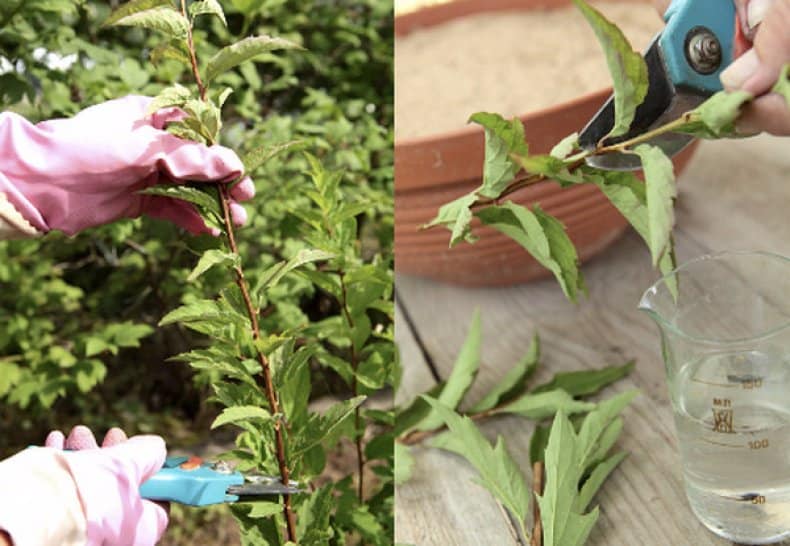
Getting spirea cuttings in spring
In May, annual shoots of brown color are taken, they are semi-lignified. The length of the cutting is chosen 12-15 centimeters, the number of internodes on it should be 4-5 pieces.
We always use twigs that grow vertically, it is good if they are straight. Taking into account the season, we help the cuttings with special stimulants so that they take root faster and more painlessly.
You can use epin, zircon (liquid preparations), then granular or powdery heteroauxin, root.
We plant the prepared cuttings in wet sand or peat, cover with polyethylene (a cut plastic bottle).Pots, containers, mini greenhouses, greenhouses or special cuttings - there are many options for planting.

Spirea cuttings in summer
In June (Japanese spirea) or July (most other species), we take shoots that have just faded, and leaves on them grow from each internode. Gardeners successfully use both green young twigs and semi-lignified annual stems.
- The length of the handle is 10-15 centimeters, the buds on it are at least 4;
- Remove the lower leaves, and cut the upper ones in half;
- Put the twigs in a solution of a root formation stimulator (epin) for 4-6 hours;
- Before planting, dip the lower cut into a dry root or heteroauxin (do not shake off);
- You need to plant in a mixture of wet sand with peat, or just in wet sand or vermiculite, in any case, the soil should be light and loose;
- We put the branches in the ground at an angle, deepening, no more than 3 centimeters.
Sprinkle some water over the shoots and cover them with plastic wrap or a plastic bottle (remove after a couple of weeks). A warm, moist environment is created for the seedlings. From time to time we water and spray the shoots, avoiding drying out and waterlogging.
Sprinkle seedlings overwintering on the street with peat or spruce branches. For the winter season, containers or boxes are also brought into the basement, the pots are left in cool rooms or on a dark windowsill.
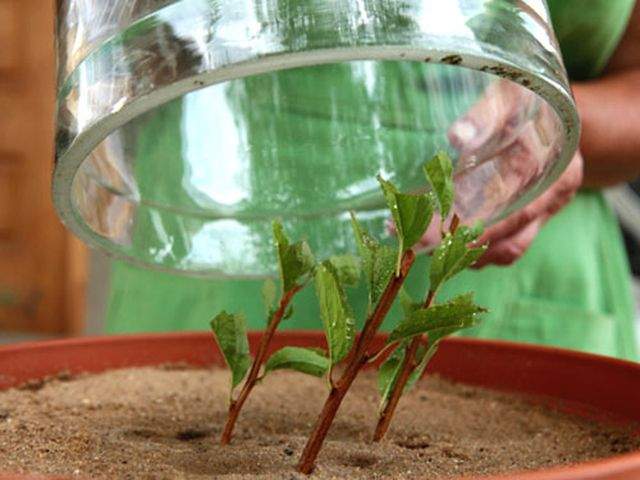
It is convenient to root spirea shoots both in a pot and in a greenhouse. I am building a kind of greenhouse for cuttings of any garden crops. I do this:
- I am digging a small bed in a sunny area;
- I bring in humus, peat and sand, water;
- I level and plant shoots at a distance of at least 10 centimeters;
- I stick in the arcs directed from east to west and cover them with polyethylene;
- I sprinkle the edges of the film with earth (you can strengthen it with bricks or boards), and shade from above with tree branches (I have bird cherry or willow);
- From the ends I do not cover with branches, there is only a film.
Sometimes we ventilate the cuttings, water them, and for the winter we remove the film cover and sprinkle the rooted seedlings with peat or humus.
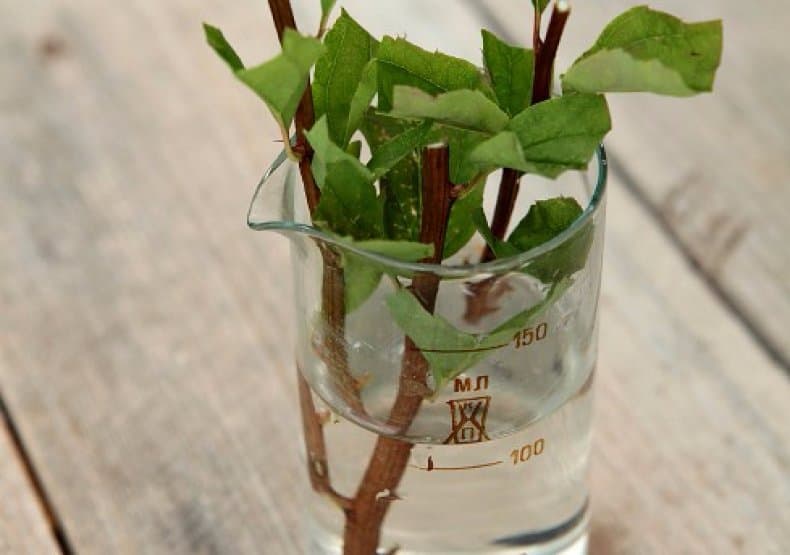
Spirea division technology
Dig up a spirea bush, capturing about 60% of the crown projection. It's okay if you have to chop off several roots that go far to the sides. Wash the roots. Young plants, in order to wash off the soil from the roots, it is convenient to simply put them in a bucket or basin of water for an hour. Damp earth is easily washed off. Spire the roots of the spirea if possible.
You can divide the spirea bush and together with an earthen lump, without washing. But in plants that were planted at one time from containers, the roots sometimes twist so that when dividing "blindly" you run the risk of leaving half of the spirea bush almost without roots.
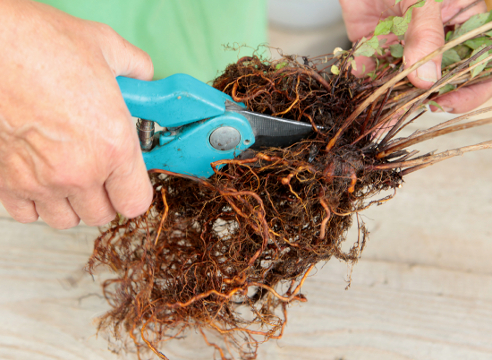
Cut the bush with pruning shears into 2-3 pieces. Each section should have at least 2-3 strong shoots and a good lobe of roots.
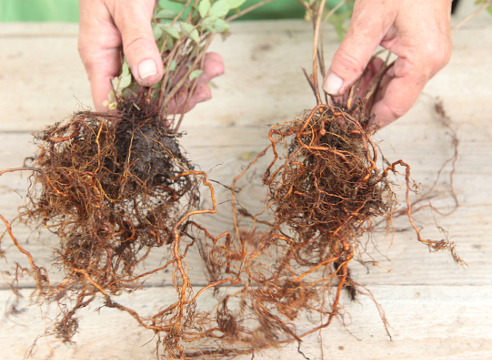
It is desirable that the divisions turn out to be more or less equivalent.

Trim the roots of the spirea: update the soaked cuts (where they are clearly visible), shorten the long cord-like roots, trimming them to the length of the others. After planting, they will begin to branch intensively, providing the plant with survival.
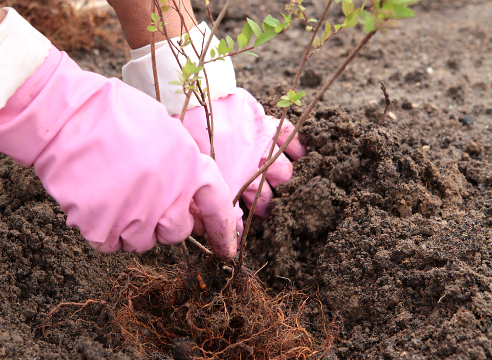
Dig a hole for planting a spirea delenka and put a mound in the middle of the hole. Place the divider on a mound and distribute the roots so that they are directed more or less evenly in different directions.
Fill the hole and water the young spireas thoroughly in several steps. In hot dry weather, spirea should be watered at least every other day, in rainy and cloudy weather - once a week. Spireas, divided in late summer and early September, take root more easily. Even if the weather is hot during the day, fog is gathering in the evening. And high humidity in warm soil promotes rooting of plants.
Reproduction of spirea by cuttings in spring
And, by the way, the purchase of seedlings is not necessary, because vegetative propagation of the spirea shrub is possible. It's about cuttings in the spring.
Reproduction of spirea by cuttings in spring - cutting off shoots
Cutting is one of the most effective spirea breeding. It is usually held in mid-summer or autumn. But if you wish, you can do this in the spring, in May. In this case, propagation of spirea by green or semi-lignified annual cuttings is used. For spring cuttings, young annual shoots are used, which grow straight and stretch upward. With a sharp knife or pruner, cut a branch into cuttings up to 10-15 cm long. Each should have 4-5 internodes (that is, pairs of leaves). Moreover, the lower internode should be cut off, leaving no petioles. Slices on cuttings should be oblique, at an angle.
Reproduction of spirea in spring - planting cuttings
In general, spirea cuttings root well. However, with the procedure carried out in the spring, special processing of the workpieces is recommended, which promotes rapid root formation. Prepared cuttings should first be placed for 4-12 hours in a solution of any biostimulant at your disposal - Epin, Albit, Energen, Zircon and others. In their absence, experienced gardeners advise using natural biostimulants, for example, aloe juice (3-5 drops in water). It will not hurt to sprinkle the ends of the cuttings with a root-forming stimulant in the form of a powder, for example, Kornevin, Heteroauxin, Ukorenit.
After this treatment, the cuttings are placed in a container with wet sand, deepening at an angle to a depth of 2-3 cm. Do not forget to spray the cuttings, and then place them under a jar or film.
Care and planting of spirea cuttings
When spirea propagates by cuttings, care and maintenance is reduced to placing the pot in a shady place in the garden, frequent spraying, watering and airing. By winter, pots with cuttings should be taken to the basement or buried in the ground. For the latter, cover the cuttings with foliage or natural cloth. With the arrival of warmth, young plants can be transplanted to a permanent place.
|
Propagation of an apple tree by cuttings Apple trees can be found in almost every garden. At the same time, few people think about the independent propagation of these trees, limiting themselves only to grafting, and after all, they can also be grafted. Read more about the propagation of apple trees by cuttings in our article. |
Why does the plum not bear fruit - what to do? Having planted a young tree in their garden, each gardener looks forward to the first harvest. But it so happens that the years go by, but the long-awaited harvest is still missing. Why the plum does not bear fruit and what to do in such a situation, we will try to figure it out in our article. |
|
How to water strawberries? The aromatic berries of ripe strawberries are strongly associated with the beginning of summer for many. But in order to get a good harvest of vitamin berries, you need to properly care for it - weed, feed, water. Read about how to water strawberries in the article. |
How to water tomatoes after planting? Almost every summer resident is engaged in growing tomatoes on his site. However, beginners often have difficulties and questions regarding the proper care of them. Our article will tell you in detail how to water tomatoes after planting. |
Home Floriculture How best to propagate Japanese spirea (meadowsweet)


